4 String Standard
Ned's revolutionary design needed a
revolutionary tuning bridge. The basic 4 string bridge was obviously
offered during the entire production run.
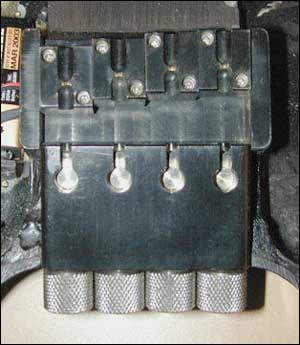
Early Brooklyn prototype L2 4 string bridge.
Note the ball ends load through the top plate.
The first L's have a two piece bridge whereby
the saddle assembly and tuners were physically separate but sat right next to
each other on the bass. These bridges were milled in-house by
Steinberger out of steel and featured the revolutionary tuning bridge with
block style saddles. These first generation bridges are now referred to
as the 4 string version 1.0 or simply v1.
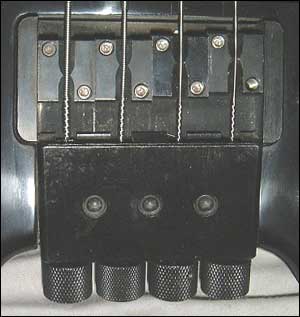
Standard v1 L2 bridge.
The 3 screws on the
top plate are a distinct feature.
When the XL's were introduced to replace the
L's, a new v2 one-piece bridge was designed. These also were made at the
Steinberger factory. They featured one-piece saddle blocks but
intonation was now made by adjusting a set screw at the front of the saddle which
in turn is attached to the bridge
housing. This allows for precise, stable intonation changes.
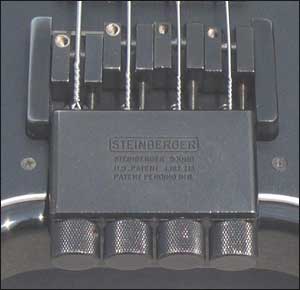
XP2 bass with v2 Newburgh made bridge.
Note the one piece saddles.
One of the main complaints about
the v2 bridges is that the one-piece steel saddle wears over time. After
prolonged use and tuning the strings can wear a groove into the
saddle. This messes with the intonation, and can often cause string
breakage when tuning - the outer wraps of the strings get caught on the sharp
edges of the groove and the core snaps under the tension.
NOTE - To prevent this you can
take a small file and round off the worn groove edges. This will keep you from
breaking strings while tuning.
With this knowledge Ned redesigned the bridge again
in the mid 80's. At this time Steinberger production was exploding and they
contracted the bridge manufacturing to Schaller Germany. These v3
bridges are still milled steel, but feature a saddle block with a channel
cut in them. A stainless steel post with a slight groove to guide the
string is inserted about 3/4 of the way up through the side. The
stainless rod/post does not show through the tops of the saddles. Of all
the bridges made these were likely in production the shortest time.
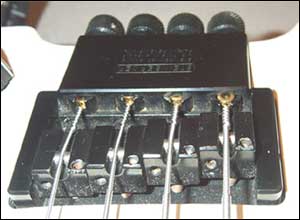
White XL2A bass with v3 Schaller made
bridge.
Note the stainless inserts inside the saddles.
As Steinberger grew and continued
to farm out machining operations they entered into an agreement with Zen-On,
a Japanese company, to produce their guitar tremolos. Steinberger
also decided to use them for their bass bridges as well, and the v4 bridge was
designed.
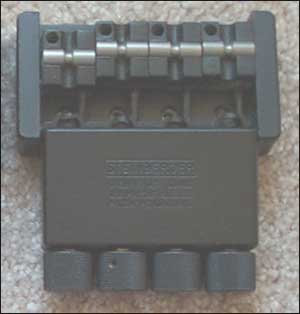
Zen-On made v4 bridge.
Note
prominence of stainless string inserts and string grooves.
This latest version of the 4
string bass bridge has similarities to both v2 & v3. The basic shape
and design is identical to v2, but the use of stainless steel inserts like in
v3 is retained. These inserts differ from the Schaller/v3 variety in
that a solid (rather than a channeled) saddle block is used with a larger
diameter brushed stainless rod inserted into the side but protruding through through the
top as well. A very noticeable U groove is milled into the rod as well.
Notably some of the components on
the v4 are not milled steel either. Rather they are hot forged from a
zinc based alloy named "zamac". Not known for great musical qualities
(it's used because it has a low melting point), some think these Zen-On made
bridges kill a bit of tone and sustain. We've found the addition of the stainless
inserts counteracts much of this potential deadness.
NOTE - Some people think that the v4
stainless insert is actually a roller saddle. This is not the case. The rod is
tightly inserted and does not move when the strings are tuned.
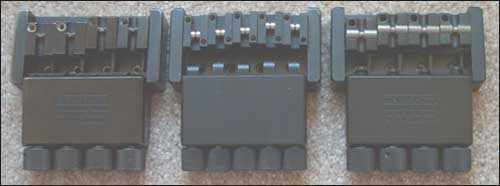
From left: v2 Newburgh 4 string, Schaller made
5 narrow, v4 Zen-On 4 string.
Bass TransTrem
Shortly after the introduction of the guitar
TransTrem in 1986, Ned
went to work on a bass version of this revolutionary bridge. Introduced
in early '87 and logically
dubbed the "Bass TransTrem" it featured the same ability to
transpose strings in tune from low B up to high C. These bridges were
actually made by HAZ Labs. Not known as a machine shop,
this was done as a favor to Ned from
Henry Zajic (HAZ Labs founder & owner).
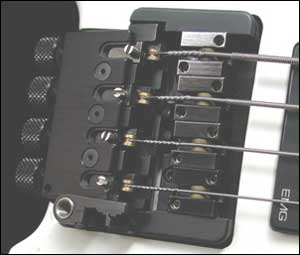
Bass TransTrem featured on a white XL2TA
bass (trem arm not pictured).
Though inspired, demand and interest in the
bass version of this tremolo was never very great. Outside of the initial
production run, no more were ever made. Best accounts are anywhere
between 140 and 200 bass TT's were produced. HAZ Labs recalls it being 2 runs
of 100, but actual documentation is non-existent. Steinberger
offered the bass TT as an option into the '90's until all existing inventory was
gone.
Though our TransTrem instruction pages are
focused on guitars, the same principles of installation, setup
and use apply to the bass version as well.
Click here for
official directions on tuning a TransTrem
Click here for helpful tips on setup and use.
DB Tuner
Bowing to the lack of consumer interest in the bass TT, Ned realized
that most bassists don't necessarily want to transpose all the strings on a 4
string bass; they primarily want to tune down a little. In 1988 the DB Tuner was born.
Officially referred to as the "DB Bridge
System" it has all of the same features of the
standard 4 string bridge (tuners, saddles, etc.) but adds one feature to the E
string - a detuning lever. With a flip of this lever you can instantly
lower the tuning from Eb down to low B. A fine tuner allows this detuned
note to be
precisely set.
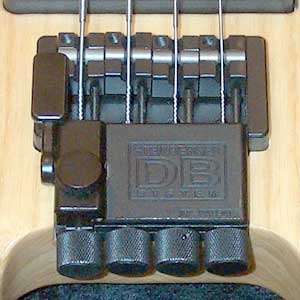
DB bridge on a newer XQ2 bass.
Note the stainless
inserts in DBv2 saddles.
There were two versions of the DB bridge: the
first (DBv1) with one-piece saddles (like on the v2 4 string bridge), and a second
Zen-On made one with the 4 string v4 type stainless insert saddles
(DBv2). Like the narrow 5's these were designed with the same universal
4 string bridge footprint, and can be/were easily interchanged with other
bridges.
5 String Narrow
From the beginning Ned realized that the
strength and rigidity of his graphite neck would allow much more tension on it
without bending - much more so than a traditional wood neck anyways. So in
1982 he introduced a narrow 5 string bridge. This bridge had the same footprint as a normal
4 string bridge but accommodated 5 strings (either low B or high C).
Steinberger offered this on new basses (dubbed the L-2/5 at the time), but you could also pick up a 5 string
narrow bridge and accompanying headpiece to swap on your existing bass.
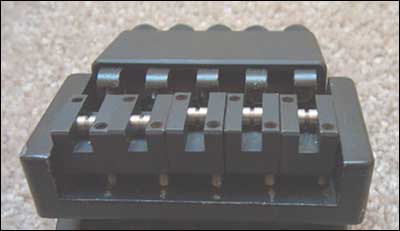
Schaller made 5 string narrow
bridge.
Notice the stainless saddle inserts and the sideways jaws.
The L versions of these bridges were made
in-house, while the XL versions appear to have been made by
Schaller featuring the same 4 string v3 stainless saddle inserts. In
actuality, Schaller re-milled standard 4 string bridge parts to use as 5 string
narrows. Because some of the attachment screws on the base of the unit were
in the way with the narrow spacing, new holes had to be drilled. If you turn one over you
can see the original unused holes.
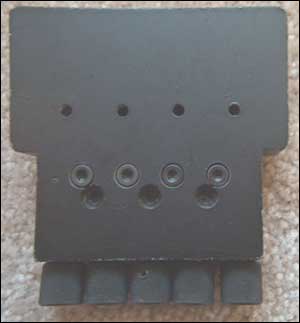
Bottom of 5 narrow bridge.
Note 3 unused
holes towards the bottom.
On standard 4 string bridges these are used to
attach the bridge top plate to the base plate.
It was not feasible to have the intonation
screws attach to the bridge in such a small footprint, so the saddles in the
narrow 5 must be attached manually (see full bridge pic above). Unlocking the side set screw release
the saddles and you then set the intonation for each string by hand.
It's also interesting to note that for some
reason (unlike their 4 string counterparts) none of these bridges has the
Steinberger name imprinted on the top plate of the bridge. Because of this
some folks think that they're not "official" Steinberger
bridges. That's not the case.
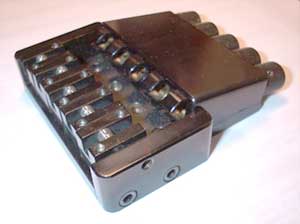
A slightly different version of the 5
string narrow bridge.
The sides are attached rather than part of the base.
As for playability some love these narrow
5's. But many
players (especially finger-style ones) complain that the string spacing is
too narrow to adequately play. Keep in mind the 5 narrow bridge reduces the normal string
spacing significantly, resulting in much more "cramped" space
between the strings. But because of Ned's ingenious design 5 narrow
bridges can usually be swapped with a 4 standard counterpart to fit a player's
needs.
5 String Wide
With the introduction of the Q5 (XQ) bass in
1990, Steinberger offered a true 5 string bass for the first time. This
bridge possessed all the general features of the 4 string bridge save one -
saddle intonation is set by hand just like the narrow 5.
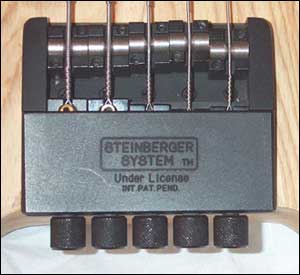
Zen-On made version of the 5 string wide bass
bridge.
To differentiate these 5 string
bridges from the narrow 5's, they are commonly referred to as "wide
5" bridges. These were featured on the Q5/XQ-25 basses and later on
the XL-5W (wide 5 XL). The original Newburgh made basses feature single-piece saddles blocks
(5Wv1) while the later ones (5Wv2) have the Zen-On style stainless
saddle inserts as seen above.
It's interesting to note that
every wide 5 bridge we've seen has the "Under License" tag you see
on the bridge above. These are not aftermarket or clone bridges -
they're the real thing. We don't know exactly why this wording is there.
5 String Wide w/
Piezos
This special bridge was created by HAZ
Labs in the final year of Gibson production (1998). HAZ built a
single unit in an XQ bass to provide Gibson a "proof of concept"
prototype. They modified the saddles on the bridge, inserted the piezo crystals,
matched the buffers, and installed all of the electronics. It is not
known if the prototype bass ever left the factory or if it still lives today.
No circuit board was used in the prototype; all
of the piezos and controls were hand wired. "It was a mess
inside that cavity" comments Henry Zajic of HAZ. "If we would have
taken it into production I would have designed a board for it, but didn't
bother for just the one." Gibson ended up moth-balling Steinberger shortly
thereafter so the idea was obviously never carried into production.
But the idea
didn't die.
In recent years Stuart Spector bought back his namesake company
and began making his own basses again. He designed a new bridge for his
instruments that included the same block style saddles as the
Steinberger. "Yeah, I basically copied Ned's design" Spector
admitted. HAZ Labs provides all of the electronics for Spector
basses, and when approached about a piezo option recalled their earlier Steinberger
work. That same prototype design was modified to fit Spector and is offered on their
basses today.











